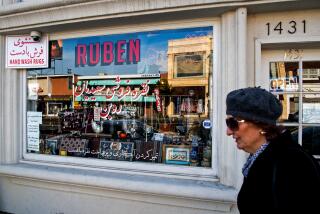The New Question: Who Is an Israeli? : ARABESQUES <i> by Anton Shammas (Harper & Row: $16.95; 272 pp.) </i>
- Share via
The publication of Anton Shammas’ novel “Arabesques” in Israel in 1986 made a stir whose ripples reached far beyond literary circles and concerns. Two interrelated facts account for much of the excitement. “Arabesques” is the first Hebrew novel to have been written by an Arab, and it is a literary feat in its own right. An English translation of the novel is about to be published by Harper & Row.
The narrative of “Arabesques” evinces an intriguing mixture of autobiography and fiction. The autobiographical thrust draws on both the writer’s personal childhood experiences in his native village of Fassuta (in upper Galilee) in the 1950s and the wanderings of the Shammas family, whose patriarch Jubran, the writer’s grandfather, set in motion when he left his birthplace in Southern Syria and settled in this Galilean village around the middle of the 19th Century. Little did this Arab patriarch know at the time that one of his sons would die impoverished and lonely in far off Argentina in 1974, and another, the writer’s father, in Haifa in 1978, or that a grandson would inscribe the family narrative in the annals of Hebrew literature.
Whether in response to the modernistic penchant for fragmenting the subject, or the need for mimetic veracity toward the reality of the Palestinian diaspora, the line of this narrative often twists and breaks as it attempts to piece together a coherent family saga from the disparate life stories of the scattered Shammases. It transpires from these charming vignettes that the gift for storytelling is hereditary in the Shammas family, except that in this case, it is passed not from father to son but from uncle to nephew. The stories the writer hears from his Uncle Yusef in childhood retain a degree of freshness and vividness seldom encountered in transcribed, let alone translated, oral literature. True to the nature of the arabesque, these narrative units are freely arranged in “The Tale” sections of the novel.
What does not come under “The Tale” heading comes under “The Teller” in “Arabesques.” The focus of narrative shifts in these sections from the past in Palestine and Israel to the present in Paris and Iowa City. The shift is occasioned by a trip the writer makes to Iowa City, via Paris, to participate in an international writers’ workshop. An intricate relationship between the writer and a Jewish Israeli novelist, who is also participating in the workshop, animates the narrative of “The Teller” sections. The Jewish writer goes to Iowa primarily to observe from close quarters his Arab counterpart after whom he seeks to model the fictional protagonist of a novel he is writing on the dilemma of the Israeli Arab intellectual.
The difference in theme between the sections of “The Tale” and those of “The Teller” yields a totally different aesthetic experience. The subject of the latter is the discourse of power relations between the Jewish majority and the Arab minority in Israel as it manifests itself in the treatment of the Arab in Hebrew fiction. In an ingenious reversal, Shammas, the Arab writer writing in Hebrew, constructs a stereotype of the Jewish writer engaged in stereotyping the Israeli Arab (whom he fondly calls “my Jew”) in Hebrew fiction. One telling sentence in “Arabesques” succinctly describes the predicament of the Israeli Arab, in and out of Hebrew fiction: “And I ask myself how I would have responded if Bar-On (the Jewish writer) had not been breathing down my neck, and whether the situation of Bar-On not breathing down my neck is at all possible, for better or for worse.”
For its self-evident literary merits: Rich and allusive language, pulsating lyricism, subtle humor, and invincible irony, “Arabesques” was received with near universal acclaim by Israeli readers and critics. The Israeli writer Amos Oz called it “a triumph, not necessarily for the Israeli society, but for the Hebrew language.” And Yael Lotan, writing in the Israeli periodical Al-Hamishmar, went as far as to call it the first truly Israeli novel because it “is based entirely on Israeli experience.”
And yet, it is precisely this uniquely “Israeli” quality of “Arabesques” that has proved most unsettling for many Israelis.
For, although it carefully steers out of political issues, the novel throws into sharp relief the fundamental contradiction in the character of Israel as a Jewish and a democratic state. Himself the accomplished product of an Israeli culture that is only partly Jewish, Shammas’ very identity tests the rigidity of the ideological formula that insists on considering the term Israeli as synonymous with Jewish and exclusionary of non-Jews.
Whether, as Lotan predicts, “Arabesques” will turn out to be the landmark that will liberate modern Hebrew fiction from the “tribal” constraints that have limited its scope and appeal thus far, remains to be seen. If Hebrew literature is at all destined to have its Conrads, Nabokovs, Becketts and Ionescos, it could not have hoped for a more auspicious beginning. For that, however, much more than literary conventions may have to change in Israel.
More to Read
Sign up for our Book Club newsletter
Get the latest news, events and more from the Los Angeles Times Book Club, and help us get L.A. reading and talking.
You may occasionally receive promotional content from the Los Angeles Times.










